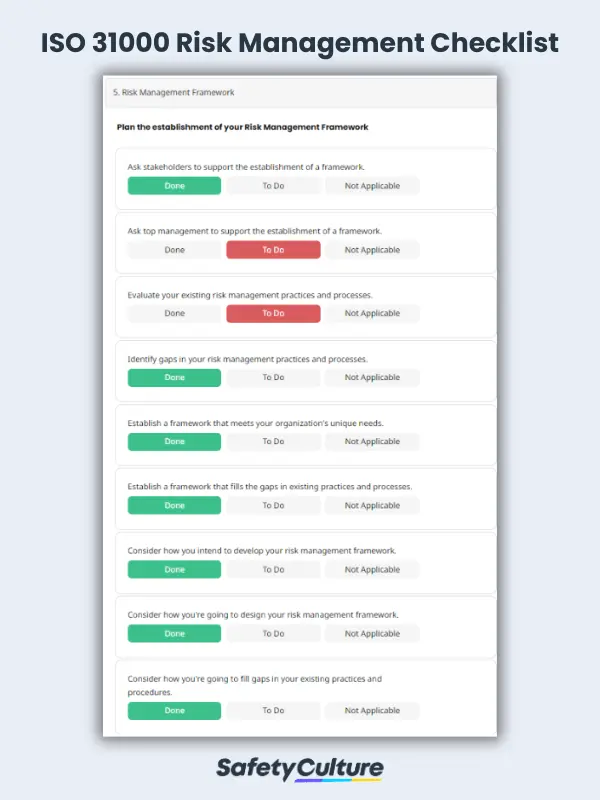What is ISO 31000 Risk Management?
ISO 31000 risk management is an internationally recognized standard that provides guidance, principles, framework, and processes to manage risks in the organization. It can be adopted of any size and industry but is not used for certification purposes. It can be used by the organization to prepare for internal or external risk management audit programmes.
The ISO 31000 is the international standard for risk management originally issued in 2009 by the ISO (International Organization for Standardization). It provides a detailed framework for the design, implementation, and maintenance of risk management on a company-wide level. It only aims to be used as a guide to help businesses compare their existing practices with international standards. Risk management standards are also a set of specific strategic procedures that intend to assist companies in their risk mitigation strategies.
What is in the Updated ISO 31000:2018?
In 2018, the ISO 31000 risk management standards were revised to allow companies more flexibility in implementing the principles in a way that suits their objectives and goals. ISO 31000 also redefined risk as the “effect of uncertainty on objectives” which emphasizes the effect of not knowing the entirety of potential challenges that can negatively impact an organization and its operations. The updated ISO 31000:2018 can serve as a guide for businesses to develop more robust risk management plans and apply them accordingly.
Here are the four major updates to ISO 31000:2018:
- Review of the principles of risk management, which are the key criteria for its success
- Focus on leadership by top management who should ensure that risk management is integrated into all organizational activities, starting with the governance of the organization
- Greater emphasis on the iterative nature of risk management, drawing on new experiences, knowledge, and analysis for the revision of process elements, actions, and controls at each stage of the process
- Streamlining of the content with a greater focus on sustaining an open systems model that regularly exchanges feedback with its external environment to fit multiple needs and contexts.
Learn more about the ISO 31000:2018 risk management standards revisions in this PDF.
ISO 31000 Risk Management Standard
The latest ISO 31000:2018 Risk Management standard is depicted as a trinity of Principles, Framework, and Processes. These three components come together to ensure:
- Principles – Sustaining a dynamic and continuously improving risk management system that is customized, innovative, dynamic, structured, and inclusive;
- Framework – Senior management leads the proactive integration of risk management on all levels of the organization; and
- Processes – Systematic application of policies and practices that support open communication, consultation, and risk reporting
With ISO 31000:2018’s iterative process to risk management, there will be a need for an organization to continuously report, review, and consider the right action to treat risks. It would be near impossible to successfully implement and sustain the ISO 31000 risk management standard if an organization’s process is heavily dependent on paper-based communication and record keeping.
How to Use the ISO 31000 Risk Management Standard
The ISO 31000 risk management standard can be used by any organization—no matter its size or sector, to establish an effective risk management framework. The standard provides guidance on how to identify, assess, treat, and communicate risks, as well as how to continually improve the risk management process. While the standard is voluntary, many organizations choose to adopt it in order to improve their risk management practices.
To use the ISO 31000 risk management standard, organizations first need to designate a risk management representative. This individual will be responsible for overseeing the risk management process, ensuring that it is followed and that the process is updated as often as necessary. Risks are then identified, this can be done through various ways such as brainstorming sessions, risk assessments, and other means.
The identified risks would then be analyzed so organizations are able to assess their impact and probability. Based on the result, risk management teams can specify which risks should be prioritized and actioned upon first.
Finally, the organization will develop and implement a risk management plan, which should be periodically reviewed and updated as needed. By following the guidance in the ISO 31000 risk management standard, organizations can establish an effective risk management process that will help them avoid or mitigate the impact of potential risks.
How to Implement ISO 31000
Organizations implementing an ISO 31000 system need to ensure that it is tailored to their specific needs, main goals, and objectives. The system should be flexible and adaptable so that it can easily be updated as circumstances change. Another important note is that it should be based on a clear and shared understanding between leaders, stakeholders, and employees about risks and how they affect the organization.
To implement the ISO 31000 standard in your organization, a risk management process should involve the following activities:
- Risk assessment – to identify, analyze, and evaluate risks.
- Risk treatment – to select and implement options for addressing risks identified.
- Monitoring and review – to ensure the quality and effectiveness of the risk management process.
- Recording and reporting – to communicate the outcome of risk management activities across the organization and to serve as a basis for decision-making, and the continuous improvement of the risk management process.
ISO 31000 can also be used with other ISO standards, such as ISO 14971.
What is an ISO 31000 Risk Management Checklist?
An ISO 31000 risk management checklist is a tool used to help organizations in identifying, assessing, and controlling threats to build a sound risk management system. It helps assess the framework for the design, implementation, and maintenance of risk management.
What to Include
Although risk management templates can differ per organization and their determined plans, checklists that include the following items help you ensure that nothing is overlooked and everything is in place:
- Company name
- Date of audit
- Risk management representative/implementer
- Location/address
- Establishment of plans for the risk management framework
- Commitment to risk management
- Management of risks per involved people
- Development of the risk management framework
- Additional comments/observations
- Signature of authorized person/people
FAQs about ISO 31000 Risk Management
ISO risk management focuses on the best practice principles for implementing, maintaining, and improving a framework for risk management. It has five components including:
- Mandate;
- Plan;
- Implement;
- Check; and
- Improve.
These components help in providing a clear and universally applicable set of guidelines for risk management.
ISO 31000 defines risk as to the effect of uncertainty on objectives. It means that every process has an element of risk that needs to be managed and every result is uncertain. It is defined in goal-oriented terms that provide a conceptual definition of risk.
One key difference between ISO 31000 and other risk management standards is that it focuses on the principles of risk management rather than specific requirements. This allows organizations to tailor their risk management processes to their specific needs. Additionally, ISO 31000 is based on a continuous improvement approach, encouraging organizations to regularly review and improve their risk management processes over time.
The structure of ISO 31000 risk management typically comprises three main components: principles, framework, and processes. The principles serve as the fundamental basis guiding the organization’s risk management efforts. Framework, meanwhile, establishes the policy, objectives, and mandate of the risk management approach. Lastly, the processes section describes the systematic steps involved in effectively managing risks.


